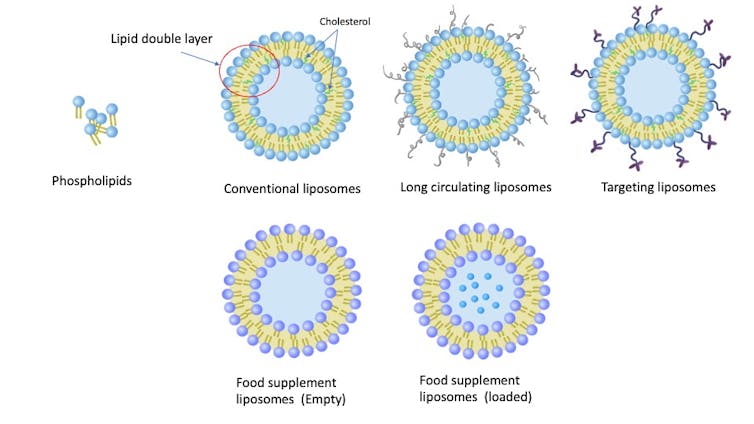Do liposomes make food supplements more effective? A chemistry expert explains common myths about these products
By Mohammad Najlah, Anglia Ruskin University
There has been an explosion in nutritional supplements that promise a superior product because they contain nanoparticles called liposomes. But there’s a lot of misleading information and outright myths about these being shared online, so it’s important to understand how liposomes work before you spend money on an expensive new food supplement.
Liposomes have been used to enhance the effectiveness of medicines since 1995. They are nano-size bubbles from a group of fatty or oily compounds called phospholipids – the building blocks of all the cells in your body. Liposomes can fuse together to form a similar structure to human cell membranes while retaining a liquid core.
This structure gives them a unique ability to carry medicines inside their shell. While many medicines would dissolve straight away on contact with your body fluids, liposome shells can protect them until they reach the part of your body the medicine is supposed to treat.
Liposome use in the pharmaceutical industry and clinical research is regulated, meaning they are tested by independent organisations to see whether they perform as well as the manufacturers claim. There is also large body of research demonstrating how effective they are as medicine carriers.
Pharmaceutical vs food supplement liposomes
People are becoming more aware that your body is better at absorbing vitamins and other nutrients from food rather than supplements. This means food supplement companies are having to work harder to convince people their products can overcome this problem.
It may seem logical that if liposomes work well for medicines, they could help your body absorb vitamins and other supplements too. But it’s not that simple. In the food supplement industry, there are a multitude of products on the market that are of poor quality or downright fake. This is due to the lack of rigorous regulation in the industry, especially for advanced formulations like liposomes.
Since their discovery in 1966, the structure of liposomes has been developed for several applications in the medical field, including prolonged circulation (making the medicine stay in your system longer), targeted delivery, and controlled release. In 1995, Doxil(R) was the first liposomal drug licensed for cancer treatment. It is a type of chemotherapy which uses liposomes to give the drug more time to reach tumour tissue, where the drug is slowly released.
But researchers achieved this using complicated processes that are expensive and demand a high level of skill. For example, some medical liposomes use cholesterol in the outer shell to keep it intact for longer.
In contrast, the liposomes used in food supplements are often the most basic, delicate type. The more delicate the liposome, the faster it breaks down.
Do liposomes enhance oral absorption?
There are conflicting reports about whether liposomes enhance gastrointestinal absorption.
Food supplement liposomes may enhance absorption by improving the ability of the nutrients they contain to fuse with other substances in your food. However, there is limited evidence that even advanced types of liposome pass through the stomach and small intestine membrane into the bloodstream.
And even if the liposomes can reach the blood intact, they will then be attacked by your immune system as a foreign substance. Medicinal liposomes are better equipped to withstand this kind of attack.

Conventional liposomes are easily destroyed in the stomach and small intestine. This means claims that such liposomes protect nutrients from stomach acid are false. The same goes for claims that conventional liposomes are absorbed into your bloodstream and remain intact. Similarly, claims that food supplement liposomes carry nutrients through the gut, into circulation, and then travel to organs are a work of fiction, as a review of 50 years of liposome research showed.
Can liposomes be used with any type of nutrient?
The simple answer is no. There are many nutrients that liposomes struggle to encapsulate for different reasons.
Firstly, some nutrients are made from molecules too big to fit inside a liposome. It would be like trying to fit a full trolley of food inside one small plastic bag. Even in pharmaceutical research, where more advanced techniques are used, some drug molecules are difficult to fit inside liposomes.
Furthermore, liposomes are not an impervious plastic bag, but more akin to a cotton bag through which water can pass. This sometimes leads to content leakage. Water-soluble materials such as vitamin C or vitamin B are thus even trickier to encapsulate than fat-soluble ones such as vitamin D, curcumin or resveratrol.
In pharmaceutics, the maximum loading is 10% drug molecules to lipid molecules (fatty compounds that perform a variety of functions in your body). This means if you take a dose, only 10% of it will consist of the drug molecules encapsulated in liposomes. In the case of food supplements, the ratio is higher but claims of 100% encapsulation efficiency are simply not possible.
And unfortunately, it is not possible to tell whether a product contains liposomes just by looking at it. Liposomal formulations are watery rather than creamy or gel-like. Manufacturers add thickening agents and other additives to make their products look more appealing – so neither colour nor thickness can tell you whether a product contains high-quality liposomes, as some companies may claim.
If a company says its products contain liposomes, always check its website for evidence such as electron microscope imaging in production. The sizes of liposomes vary, but it is impossible to see them without a microscope.
While it might be possible to see larger liposomes using a quality light microscope, the smaller and more effective liposomes are measured in nanometres. They can only be seen with more sophisticated, electron-scanning microscopy.
Ultimately, until there is better regulation of nutritional supplements, it is difficult to verify these businesses’ claims about how they make their products, and what is and isn’t in them.![]()
Mohammad Najlah, Professor of Pharmaceutics & Nanomedicine, Anglia Ruskin University
This article is republished from The Conversation under a Creative Commons license. Read the original article.




